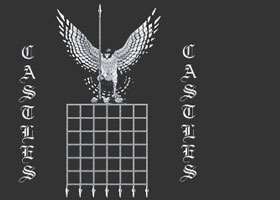| | The English castle, as we generally recognise it, was built of stone during the Medieval era. But the story of the history of the castle goes back to the Hillforts of the The Bronze Age ( 1800 - 600 BC ) and the later, more advanced, Hillforts of the Iron Age ( 600 BC - 400 AD ). The history of the castle therefore can date back to the time of the Bronze and Iron Age Hillforts! The forts, or fortresses, which sat on the top of hills! Bronze and Iron Age Architecture Maiden Castle | | | |
| | The History of the Hillforts
When looking at the History of the English castle we need to look for people who worked together to create, or build, a safe retreat against intrusion or invasion! This applies to people living in England and building structures called Hillforts during the Bronze and Iron Age. The need for Hillforts arose because of: |
- Tribal disputes and warfare
- More sophisticated and lethal weapons made of Bronze and then Iron
The construction of Hillforts following the development of new weapons using Bronze and Iron material saw the introduction of the sling and the war chariot. This pattern of fortress development due to more sophisticated weapons continued up to the English Medieval Castles. Remains and evidence of sites of more than 2000 Hillforts have been found in Britain. HillfortsHillforts - What were the Hillforts for?
- Who built the Hillforts and why?
- What did a Hillforts look like?
- What was the purpose of the Hillforts?
- How were Hillforts constructed?
- In what ages were Hillforts first built?
What was the purpose of Hillforts?
A Hillfort was built as an enclosed area which was used for: - A meeting place for formal tribal purposes
- Trading
- Many were permanently occupied by people
- They were a safe retreat against intrusion from raids from other tribes
- Provided shelter for rising population levels
- Provided shelter against harsh winters and wild animals
- Provided a place for safe animal compounds or enclosures
Small Hillforts were built to defend small homestead or even small villages. Large Hillforts were also a Symbol of Power
During the Bronze and Iron Age the population grew and strong communities developed. Each community, or tribe, was led by a leader, or a King, who was supported by powerful families. Larger Hillforts were used as regional capitals or seats of Government. The Hillforts herald the dawning of the Feudal system prevalent during the Dark Ages and the Middle Ages of the Medieval period. |
What did Hillforts look like?
Hillforts varied in size, shape and design but a good description would include the following elements: - Hillforts were built on hilltops or high ground
- They were surrounded by at least one concentric bank and ditch
- Hillforts were constructed using stone, soil and wood - Timber was favoured as it was clearly lighter to transport up the hilltops and was used for strengthening the ramparts and for interior building construction
- Some Hillforts were massive and covered and enormous area of over 300 acres!
- Each Hillfort had a rampart - an embankment built around a space for defensive purposes
- Some had Palisades - A fence of pales forming a defence barrier or fortification
- A pale was a fence made with a stake or pointed stick which enclosed the area
- Some Hillforts had a parapet - a low wall along the top of the rampart
- Within their interior, protected by the defences, Hill forts contained detached buildings - homesteads, or farmhouses, granaries and communal gathering areas
- The entrance to living areas was through a large wooden gate - the weakest point of the Hillfort - but there was not enough metal available to effectively enforce the strength of the wooden gate - not even metal nails were used
- This weakness led to the introduction of Guardhouses which were built either side of the gate
- A separate defensive tower structure, called a Barbican, was eventually added to provide additional cover
- The biggest Hillfort was called Maiden Castle
Who built the Hillforts?
Hillforts varied in size but it is certain that the largest Hillforts required the labour of hundreds, possibly thousands of Bronze and Iron Age people - many of whom would have been slaves. Why were Hillforts so important?
Hillforts are extremely important to English castle history and evolution. They mark the transition to an organised community of people with leaders or Kings. The are many similarities between the Hillforts and the Medieval castles. |
|
|

